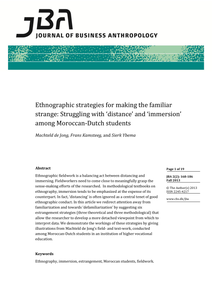DOCUMENT
Titel: The Exodus from the Netherlands or Brain Circulation: Push and Pull Factors of Remigration among Highly Educated Turkish Dutch Auteurs: Gürkan Çelik and Ton Notten In: European Review, 22 (3), 2014, pp. 403-413 The exodus from the Netherlands or brain circulation: Push and pull factors of remigration among highly educated Turkish-Dutch An increasing number of Turks, the Netherlands’ largest ethnic minority, are beginning to return to their country of origin, taking with them the education and skills they have acquired abroad, as the Netherlands faces challenges from economic difficulties, social tension and increasingly powerful right wing parties. At the same time Turkey’s political, social and economic conditions have been improving, making returning home even more appealing for Turkish migrants at large. This article gives explanations about the push and pull factors of return migration. The factors influencing return to one’s country of origin are “pulls”. It is assumed that remigration is more affected by positive developments in the country of origin than by negative developments in the country of residence. Civil society, business world and the Dutch government can develop policies to bind these capable people to the Netherlands, at least in the form of “brain circulation” so that they can serve as “bridge builders” between the two countries. Keywords Return migration, integration, Turkish-Dutch, Turkish migrants, brain circulation =============================================================================== SAMENVATTING De uittocht uit Nederland of breincirculatie: Push- en pull-factoren van remigratie onder hoogopgeleide Turkse Nederlanders. In Nederland zien we een lichte toename van het aantal Turken, de grootste etnische minderheidsgroep in Nederland, die terugkeren naar hun land van herkomst. Ze exporteren daarmee goede opleidingen en vaardigheden die ze in Nederland verwierven. De oorzaken: de economische neergang, sociale spanningen en de groeiende invloed van extreemrechtse partijen. Tegelijkertijd verbeteren in Turkije de politieke, sociale en economische omstandigheden die steeds meer aantrekkingskracht uitoefenen op immigranten in dat land. Dit artikel gaat in op de push- and pull-factoren voor remigranten. Pull-factoren beinvloeden iemands terugkeer naar zijn land van herkomst. Aangenomen wordt dat zo’n remigratie sterker wordt bevorderd door positieve ontwikkelingen in het land van herkomst dan door negatieve (push-factoren) in het land waar men op dat moment woont. De civil society, het bedrijfsleven en de Nederlandse overhead kunnen een beleid ontwikkelen dat verdienstelijke inwoners weet te behouden, hen op z’n minst kan inschakelen als bruggenbouwers en aldus kenniscirculatie mogelijk maakt tussen beide landen. Trefwoorden Retourmigratie, integratie, Turkse Nederlanders, Turkse migranten, kenniscirculatie, breincirculatie
DOCUMENT

Ethnographic fieldwork is a balancing act between distancing and immersing. Fieldworkers need to come close to meaningfully grasp the sense-making efforts of the researched. In methodological textbooks on ethnography, immersion tends to be emphasized at the expense of its counterpart. In fact, ‘distancing’ is often ignored as a central tenet of good ethnographic conduct. In this article we redirect attention away from familiarization and towards ‘defamiliarization’ by suggesting six estrangement strategies (three theoretical and three methodological) that allow the researcher to develop a more detached viewpoint from which to interpret data. We demonstrate the workings of these strategies by giving illustrations from Machteld de Jong’s field- and text-work, conducted among Moroccan-Dutch students in an institution of higher vocational education.
DOCUMENT

Various studies suggest that the fashion and textile industry need to move away from traditional, extractive leadership models. Dreier et al. (2019) show how traditional top-down, hierarchical leadership approaches are not effective in fostering sustainability, and argued that a more collaborative, participative approach is needed to implement true and long-standing change. Moreover, research also shows how fashion and textile designers don’t see themselves as leaders but instead as ‘creators’ who employ others to manage their business and lead the team. This change in leadership is also necessary to achieve the European vision for Industry 5.0 (2022), which places the wellbeing of the worker at the centre of the production process. If we want to find solutions to the problems we face today, we need to change the way we think, lead, and do business. This calls for regenerative leadership which involves not only minimising negative impacts, but also actively working to restore and enhance the social ecological systems in which an industry operates. And since technology has become ubiquitous in every aspect of our lives (including business), it is important to explore its role in helping us become better regenerative leaders. With ReLead, The Hague University of Applied Sciences (THUAS) aims to amplify consortium partner i-did’s social and environmental impact. Since its inception in 2009, i-did has helped more than 400 people become gainfully employed while helping recycle almost 60.000 kgs of textile waste. This has been possible due to the transformation of i-did’s founder (Mireille Geijsen) from a creative designer, into a collaborative and mindful leader. The intended outcome of this project is to create a tech-enabled leadership transformation toolkit and leadership academy that helps creative designers transform into regenerative leaders.